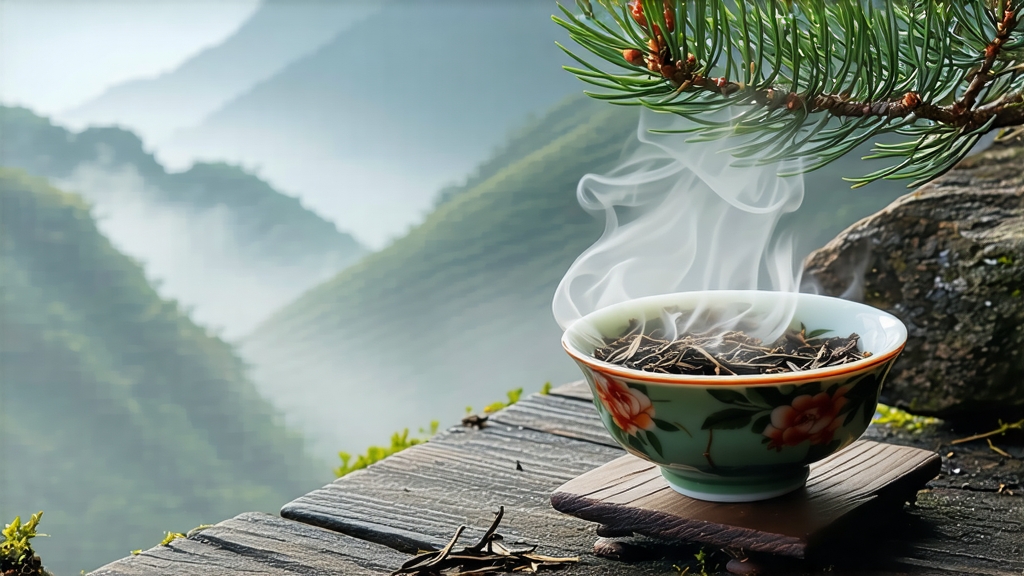
Ask most tea lovers to name a Chinese black tea and they will answer Keemun or Dian Hong; ask historians which black tea first crossed oceans and built empires, and the reply is the same: Lapsang Souchong. Born in the rugged Wuyi Mountains of northern Fujian, this pine-smoked pioneer is the prototype from which every subsequent black tea descends. Its story begins in the late Ming dynasty, around 1600, when passing armies delayed the spring harvest. Eager to dry the leaves before mold set in, farmers rushed them over burning pine boughs. The accidental smoke infusion proved irresistible to Dutch traders docked at nearby Xiamen, who bought every basket and introduced “bohea” (from the local Wuyi dialect) to Europe. Within decades London coffeehouses were advertising “souchong” as the fashionable stimulant of the Enlightenment, and the global black-tea trade was born.
Despite its fame abroad, Lapsang Souchong remains curiously misunderstood. Travelers expect an aggressive, tarry liquor, yet the authentic leaf from Tongmu village is subtle: a glowing amber cup that carries the scent of a distant campfire rather than a creosote soak. The confusion arises because two very different products share one name. The original, called “Xiao Zhong” locally, is crafted only inside the 600-m-high core zone of the Wuyi National Nature Reserve, where strict forestry laws limit output to roughly 5 000 kg a year. Outside this micro-terroir, larger factories produce an export-grade version heavily scented with extra smoke to satisfy nostalgic markets. Knowing the distinction is the first step toward appreciating the tea’s true voice.
The cultivar responsible is the Wuyi Caicha, a small-leaf, slow-growing landrace adapted to mineral-rich, yellow-red soil and the canyon mists that filter 30 % of direct sunlight. Spring buds emerge in late April, clothed in fine down and carrying a lower catechin-to-theaflavin ratio than southern cultivars, which translates into natural sweetness once oxidation occurs. Picking standard is one bud and two leaves for premium grades, lengthening to one bud and three or four leaves for the more affordable “zhong shen” pluck. Leaves must reach the factory within three hours; any delay starts uncontrolled enzymatic activity that even smoke cannot mask.
Withering happens in the second-floor loft of traditional wooden houses, where bamboo trays rest above charcoal-heated chambers. The goal is not rapid moisture loss but a gentle coaxing of grassy volatiles, accomplished by alternating natural breeze and light warmth for 8–10 hours until the leaf feels velvety and emits a faint orchard-fruit aroma. Rolling follows the “long knead” technique: 45 min of machine-assisted pressure that breaks cell walls without overheating the leaf, followed by 15 min of hand rolling to tighten the strip. Oxidation is conducted on rattan mats stacked inside cedar-lined boxes; temperature is held at 24 °C with 85 % humidity for 3.5 h, during which the leaf turns from jade to copper and develops notes of dried longan.
What sets Lapsang Souchong apart is its smoke phase, yet even here nuance reigns. Pinus massoniana, the Chinese red pine, is felled only after winter sap descent; the resin content then is half that of summer, preventing acrid terpenes. Logs are split, air-dried for six months, then burned beneath a brick chamber whose ceiling is perforated with tiny vents. Freshly oxidized tea is spread on bamboo sieves inserted into the upper tier; for 30 min the leaves absorb cool, aromatic smoke that has already lost its sharp edges. Crucially, the fire is never allowed to flame—smoldering embers maintain 70 °C, just enough to fix the leaf and fuse pine lactones with theaflavins. A second, shorter smoking may occur after sorting if the master feels the cup lacks depth, but over-smoking is considered a grave error, masking the honeyed Wuyi minerality that connoisseurs prize.
Drying completes the craft. Leaves are transferred to a charcoal oven built from volcanic tuff, whose gentle infrared heat drives residual moisture down to 3 % while caramelizing surface sugars. The finished maocha is hand-sorted into three grades: Wuyi Zheng Shan (pure bud), Zheng Shan